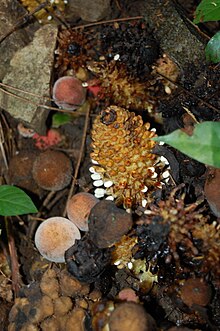| Revision as of 23:47, 18 May 2020 editWimpus (talk | contribs)Extended confirmed users2,917 edits Undid revision 957459179 by Gderrin (talk) The other source is more reliable and your source contains an obvious mistake.Tag: Undo← Previous edit | Revision as of 00:00, 19 May 2020 edit undoGderrin (talk | contribs)Autopatrolled, Extended confirmed users, Page movers, New page reviewers58,564 edits Undid revision 957459409 by Wimpus (talk)"Obvious" and "correct" are subjective words. Try consensus.Tag: UndoNext edit → | ||
| Line 22: | Line 22: | ||
| ==Taxonomy== | ==Taxonomy== | ||
| The genus was first described in 1775 by ] and his son ] in ''Characteres Generum Plantarum''.<ref name="IPNI">{{IPNI| id = 3817-1|accessdate = 22 April 2016 | The genus was first described in 1775 by ] and his son ] in ''Characteres Generum Plantarum''.<ref name="IPNI">{{IPNI| id = 3817-1|accessdate = 22 April 2016 | ||
| }}</ref><ref name="Forster">{{cite book|last1=Forster|first1=Johann Reinhold|last2=Forster|first2=Georg|title=Characteres Generum Plantarum|date=1775|publisher=White, Cadell & Elmsly|location=London|page=99|url=https://www.biodiversitylibrary.org/item/23365#page/115/mode/1up|accessdate=22 April 2016}}</ref> The name is derived from the ] words |
}}</ref><ref name="Forster">{{cite book|last1=Forster|first1=Johann Reinhold|last2=Forster|first2=Georg|title=Characteres Generum Plantarum|date=1775|publisher=White, Cadell & Elmsly|location=London|page=99|url=https://www.biodiversitylibrary.org/item/23365#page/115/mode/1up|accessdate=22 April 2016}}</ref> The name is derived from the ] words ''balanos'' meaning "acorn" or "glans" and ''phoros'' meaning "to bear".<ref name="Kew">{{cite book |last1=Christenhusz |first1=Maarten J.M. |last2=Fay |first2=Michael F. |last3=Chase |first3=Mark W. |title=Plants of the World: An Illustrated Encyclopedia of Vascular Plants |date=2017 |publisher=Royal Botanic Gardens, Kew |location=Richmond |isbn=9781842466346 |page=425}}</ref> | ||
| === Species === | === Species === | ||
Revision as of 00:00, 19 May 2020
| Balanophora | |
|---|---|

| |
| Balanophora fungosa subsp. indica found in northwest Thailand (Hup Patad cave) | |
| Scientific classification | |
| Kingdom: | Plantae |
| Clade: | Tracheophytes |
| Clade: | Angiosperms |
| Clade: | Eudicots |
| Order: | Santalales |
| Family: | Balanophoraceae |
| Genus: | Balanophora J.R.Forst. & G.Forst. |
| Type species | |
| Balanophora fungosa J.R.Forst. & G.Forst. | |
| Species | |
|
See text | |
| Synonyms | |
| |
Balanophora is a genus of parasitic plants in the family Balanophoraceae found in parts of tropical and temperate Asia, including the Eastern Himalayas, Malesia region, Pacific Islands, Madagascar, and tropical Africa. There are about 20 accepted species, including the newly discovered B. coralliformis. Many species emit an odour which possibly attracts pollinators in the same way that pollinators are attracted to Rafflesia.
Balanophora species are used in folk medicine in many Asian cultures. For example, in China, Balanophora is known as she-gu (stone-fungus) and in Thailand as hoh-ra-tao-su-nak. In both cases, the plant is used to treat a variety of ailments and has various ritual purposes. The tubers of Balanophora are rich in a wax-like substance which is used in Java as a fuel for torches.
Taxonomy
The genus was first described in 1775 by Johann Reinhold Forster and his son Georg Forster in Characteres Generum Plantarum. The name is derived from the Ancient Greek words balanos meaning "acorn" or "glans" and phoros meaning "to bear".
Species
As of March 2017, the following species are accepted at The Plant List:
- Balanophora abbreviata Blume
- Balanophora coralliformis Barcelona, Tandang & Pelser
- Balanophora cucphuongensis Ban
- Balanophora dioica R.Br. ex Royle
- Balanophora elongata Blume
- Balanophora fargesii (Tiegh.) Harms
- Balanophora fungosa J.R.Forst. & G.Forst. (type species)
- Balanophora harlandii Hook.f.
- Balanophora involucrata Hook.f. & Thomson
- Balanophora japonica Makino
- Balanophora latisepala (Tiegh.) Lecomte
- Balanophora laxiflora Hemsl.
- Balanophora lowii Hook.f.
- Balanophora nipponica Makino
- Balanophora papuana Schltr.
- Balanophora polyandra Griff.
- Balanophora reflexa Becc.
- Balanophora subcupularis P.C.Tam
- Balanophora tobiracola Makino
- Balanophora wilderi Setch.
- Balanophora yakushimensis Hatus. & Masam.
The following names are unresolved:
- Balanophora capensis Eckl. & Zeyh. ex Eichler
- Balanophora dentata Tiegh.
- Balanophora pierrei Lecomte
References
- O'Neill, Alexander; Rana, Santosh (26 July 2018). "Root holoparasite Balanophora polyandra Griff. (Balanophoraceae) in eastern Himalaya (Sikkim, India): distribution, range, status and threats". Journal of Threatened Taxa. 10 (8): 12123–12129. doi:10.11609/jott.3644.10.8.12123-12129.
- "Balanophora J.R. Forst. & G. Forst". Tropicos.org.Missouri Botanical Garden. Retrieved 26 January 2015.
- ^ O'Neill, A.R.; Rana, S.K. (2019). "An ethnobotanical analysis of parasitic plants (Parijibi) in the Nepal Himalaya". Journal of Ethnobiology and Ethnomedicine. 12 (14). doi:10.1186/s13002-016-0086-y.
- ^ "Search results for Balanophora". The Plant List. Retrieved 30 March 2017.
- ^ Jin, Chee Beng; Hoo, Lau Kah (2010). "Balanophora:the hidden highland parasite with unexplored medicinal potential". Malaysian Naturalist: 20–21. Retrieved 30 March 2017.
- "Balanophoraceae". Flora Malesiana. Retrieved 30 March 2017.
- "Balanophora". International Plant Names Index (IPNI). Royal Botanic Gardens, Kew; Harvard University Herbaria & Libraries; Australian National Botanic Gardens. Retrieved 22 April 2016.
- Forster, Johann Reinhold; Forster, Georg (1775). Characteres Generum Plantarum. London: White, Cadell & Elmsly. p. 99. Retrieved 22 April 2016.
- Christenhusz, Maarten J.M.; Fay, Michael F.; Chase, Mark W. (2017). Plants of the World: An Illustrated Encyclopedia of Vascular Plants. Richmond: Royal Botanic Gardens, Kew. p. 425. ISBN 9781842466346.
- Balanophora coralliformis (Balanophoraceae), a new species from Mt. Mingan, Luzon, Philippines
- Those Who do not Chlorophyll Lithophytic
| Taxon identifiers | |
|---|---|
| Balanophora |
|
This Santalales-related article is a stub. You can help Misplaced Pages by expanding it. |